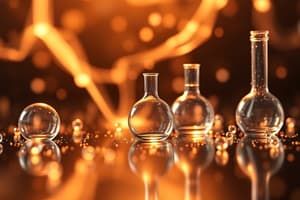Podcast
Questions and Answers
Which type of intermolecular force is responsible for the attraction between two molecules with permanent dipoles?
Which type of intermolecular force is responsible for the attraction between two molecules with permanent dipoles?
- London dispersion forces
- Ion-dipole forces
- Dipole-dipole forces (correct)
- Hydrogen bonding
What is the term for the reactant that is completely consumed first in a chemical reaction, limiting the amount of product formed?
What is the term for the reactant that is completely consumed first in a chemical reaction, limiting the amount of product formed?
- Limiting reactant (correct)
- Catalyst
- Product
- Excess reactant
What is the term for the energy required to break a chemical bond?
What is the term for the energy required to break a chemical bond?
- Enthalpy
- Heat of reaction
- Bond energy (correct)
- Activation energy
Which type of reaction involves the combination of two or more substances to form a new substance?
Which type of reaction involves the combination of two or more substances to form a new substance?
What is the equation that relates the concentration and volume of a solution before and after dilution?
What is the equation that relates the concentration and volume of a solution before and after dilution?
What is the term for the graphical representation of energy changes during a reaction?
What is the term for the graphical representation of energy changes during a reaction?
What is the relationship between the pressure and volume of a gas at constant temperature, as stated by Boyle's Law?
What is the relationship between the pressure and volume of a gas at constant temperature, as stated by Boyle's Law?
Which of the following nuclear reactions involves the combination of two or more nuclei to form a single, heavier nucleus?
Which of the following nuclear reactions involves the combination of two or more nuclei to form a single, heavier nucleus?
What is the arrangement of electrons in an atom, represented by notation such as 1s² 2s² 2p⁶?
What is the arrangement of electrons in an atom, represented by notation such as 1s² 2s² 2p⁶?
Which type of bond is characterized by the transfer of electrons?
Which type of bond is characterized by the transfer of electrons?
What is the theory used to predict the shape of a molecule, based on the arrangement of electrons?
What is the theory used to predict the shape of a molecule, based on the arrangement of electrons?
Which of the following is a characteristic of ionic compounds?
Which of the following is a characteristic of ionic compounds?
What is the term for the process by which a radioactive substance loses half of its radioactivity?
What is the term for the process by which a radioactive substance loses half of its radioactivity?
What is the measure of an atom's ability to attract electrons in a bond?
What is the measure of an atom's ability to attract electrons in a bond?
Flashcards are hidden until you start studying
Study Notes
Unit 1: Gas Laws
- Relationship between Pressure (P), Volume (V), Temperature (T), and Moles (n) is described by the Ideal Gas Law: PV=nRT
- Boyle's Law states that P1V1=P2V2
- Charles' Law and Avogadro's Law are also important gas laws
- Kinetic Molecular Theory describes the behavior of gas particles, assuming particles are in constant random motion, collisions are elastic, and no intermolecular forces
Unit 2: Atoms
- Nuclear Reactions: Fission, Fusion, Alpha Decay, Beta Decay, and Gamma Decay
- The Nucleus of an Atom contains protons and neutrons
- Isotopes: Atoms with the same number of protons but different numbers of neutrons
- Radioactive Decay: Alpha (α) decay, Beta (β) decay, Gamma (γ) decay, and Half-Life: Time it takes for half of a radioactive sample to decay
Unit 3: Electrons and Bonding
- Electron Configurations: Arrangement of electrons in an atom, noted by notation (e.g., 1s² 2s² 2p⁶)
- Spectra: Emission and Absorption Spectra, used to identify elements
- Electron Shielding: Inner electrons shield outer electrons from the full charge of the nucleus
- Electronegativity: Measure of an atom's ability to attract electrons in a bond
Unit 4: Bonds
- Types of Bonds: Ionic (Transfer of electrons), Covalent (Sharing of electrons), and Metallic (Free-flowing electrons in metals)
- Ionic Compounds: Formed from positive and negative ions, with properties like high melting points and conductivity when molten or dissolved in water
- Polyatomic Ions: Ions composed of two or more atoms covalently bonded (e.g., NH₄⁺, SO₄²⁻)
Unit 5: Molecules
- Periodic Table Trends: Atomic radius, Ionization Energy, Electron Affinity, Electronegativity
- Lewis Structures and Structural Formulas: Representation of molecules showing how atoms are bonded
- Molecule Shapes and Isomers: VSEPR theory for predicting shapes, Isomers: Compounds with the same formula but different structures
- Polar/Non-polar: Polar molecules have uneven distribution of charge, Non-polar molecules have even distribution of charge
- Intermolecular Forces (IMFs): Dipole-dipole, Hydrogen Bonding, London Dispersion Forces
Unit 6: Reactions
- Balancing Reactions: Ensuring the same number of each type of atom on both sides of the equation
- Types of Reactions: Synthesis, Decomposition, Single Replacement, Double Replacement, Combustion
- Stoichiometry: Calculations based on balanced chemical equations
- Limiting Reactants: The reactant that is completely consumed first, limiting the amount of product formed
Unit 7: Energy in Reactions
- Exothermic/Endothermic Reactions: Exothermic releases heat, Endothermic absorbs heat
- Energy Diagrams: Graphical representation of energy changes during a reaction
- Heat of Reaction: The change in enthalpy (ΔH) during a reaction
- Bond Energy: Energy required to break a bond
Unit 8: Solutions
- Mixtures and Solutions: Mixture is a combination of two or more substances, Solution is a homogeneous mixture of solute dissolved in solvent
- Calculating Concentrations and Dilutions: Concentration is amount of solute per unit volume of solution (e.g., molarity M = moles/L), Dilution: C1V1=C2V2 (Concentration and volume before and after dilution)
Studying That Suits You
Use AI to generate personalized quizzes and flashcards to suit your learning preferences.




